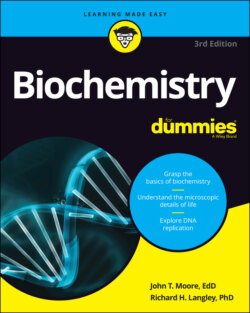Читать книгу Biochemistry For Dummies - John Moore T., Richard Langley H., John T. Moore - Страница 18
Water’s most important biochemical role: The solvent
ОглавлениеThe polar nature of water means that it attracts (soaks up) other polar materials. Water is often called the universal solvent because it dissolves so many types of substances. Many ionic substances dissolve in water because the negative ends of the water molecules attract the cations (positively charged ions) from the ionic compound (a compound resulting from the reaction of a metal with a nonmetal) and the positive ends attract the anions (negatively charged ions). Covalently bonded (resulting from the reactions between nonmetals) polar substances, such as alcohols and sugars, also are soluble in water because of the dipole-dipole (or hydrogen-bonding) interactions. However, covalently bonded nonpolar substances, such as fats and oils, aren’t soluble in water. Check out Chemistry For Dummies (written by this book’s coauthor, John T. Moore, and published by Wiley) for a discussion of chemical bonding.
Polar molecules, because of their ability to interact with water molecules, are classified as hydrophilic (water-loving). Nonpolar molecules, which don’t appreciably interact with (dissolve in) water, are classified as hydrophobic (water-hating). Some molecules are amphipathic because they have both hydrophilic and hydrophobic regions.
Figure 2-2 shows the structure of a typical amphipathic molecule. The molecule appears on the left of Figure 2-2, with its hydrophilic and hydrophobic regions shown. The right side of Figure 2-2 is a symbolic way of representing the molecule. The round head is the hydrophilic portion, and the long tail is the hydrophobic portion.
FIGURE 2-2: Structure of a typical amphipathic (both water-loving and water-hating) molecule.
Certain amphipathic molecules, such as soap molecules, can form micelles, or very tiny droplets that surround insoluble materials. This characteristic is the basis of the cleaning power of soaps and detergents. The hydrophobic portion of the molecule (a long hydrocarbon chain) dissolves in a nonpolar substance, such as normally insoluble grease and oil, leaving the hydrophilic portion (commonly an ionic end) out in the water. Soap or detergent breaks up the grease or oil and keeps it in solution so it can go down the drain.
A micelle behaves as a large polar molecule (see Figure 2-3). The structure of a micelle is closely related to the structure of cell membranes.
FIGURE 2-3: Structure of a micelle, composed of amphipathic molecules, with their hydrophilic heads pointing out.
